The decision to upgrade from three-axis to more should not be taken lightly
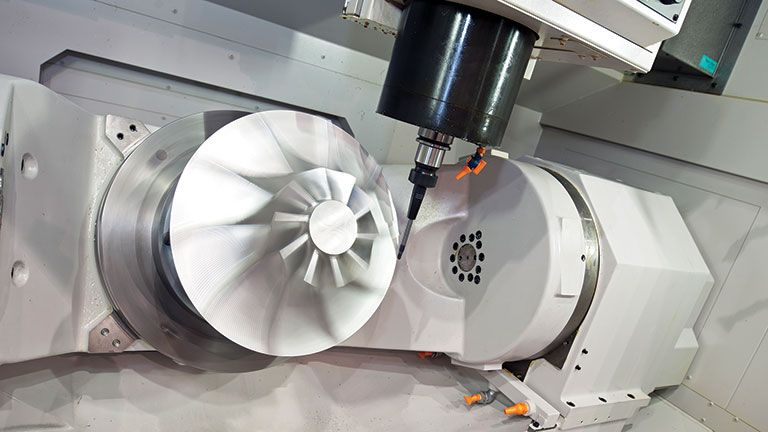
The three-axis vertical machining center (VMC) has long been the go-to machine tool for many small to medium-sized shops. Their use is well-understood. Compared to more complex machinery, it’s easier to find operators for three-axis machines. Programming, set up, and maintenance is easier as well. Perhaps best of all for cash-strapped shops is the fact that good quality, relatively affordable three-axis VMC mills are abundant, far more so than their horizontal and five-axis cousins.
And yet, given the increasing popularity of five-axis machining centers, it seems they will soon represent the new workhorse in many shops. After all, who wants to settle for milling and drilling the top of a workpiece when five axes allow manufacturers to machine all but the bottom locating surface? Why not avoid multiple operations whenever possible and the investment in workholding that these entail? And why not decrease lead times and work-in-progress (WIP) while increasing profitability?
These are all excellent questions. Do the math, then add in the greater usability and falling costs of five-axis machine tools, and manufacturers are left with yet another question: is the three-axis VMC going the way of mechanical screw machines and hand-ground tool bits? That’s unlikely.
The Power of Five
Even the most ardent five-axis fan will admit that three-axis CNC mills have their place, and while the two may need to share the same throne, neither will be toppled from it anytime soon. One such fan is Michael Cope, product technical specialist at Indianapolis-based Hurco Companies Inc., Indianapolis, who even had the audacity to write a book on the topic. “The pros of five-axis machining centers are pretty obvious, and adding one to any shop would be a great decision, but three-axis machines have some pros as well,” he said.
Cope noted that many five-axis machine configurations have smaller tables, typically round “platters” that limit the size of the workpiece as well as the quantity that can be produced in a machining cycle. This also makes the darling of most milling departments—the 6" machinist’s vise—unwelcome, let alone the two or more of them found on a typical 20 x 40" (508 x 1,016-mm) VMC. The flip side to this is that five-axis workholding is now readily available, and moving away from the machinist’s vise mentality forces shops to evaluate new ways to hold parts, inspiring creative approaches to workpiece fixturing.
Five-axis also inspires more creative and productive ways to machine those workpieces. This is particularly true for moldmaking, Cope said, where the ability to tilt the spindle when milling deep cavities allows the use of shorter tools and circle segment cutters, a.k.a. barrel mills. This in turn produces a more rigid setup, with faster feed rates, deeper cuts, greater tool life, less chatter, and fewer of the surface finish and part accuracy problems that arise from the long, skinny tooling needed on three-axis CNC mills.
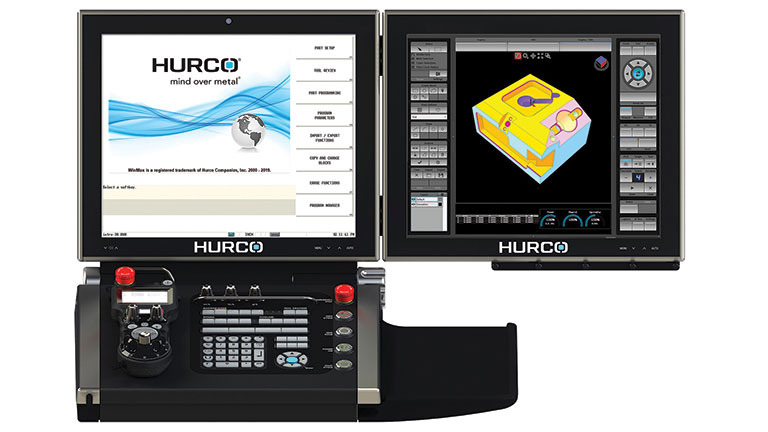
Beyond Molds
Similar benefits apply to those doing non-moldmaking work. “Traditional job shops are beginning to move away from three-axis machines, not so much because of part complexity but because they need to increase shop efficiency and throughput,” said Cope. “They’ve begun to realize that a five-axis machine lets them reduce setups and potentially increase part accuracy because several sides can be machined in a single operation. They can react faster to their customers’ changing needs, and because having a five-axis machine allows them to look for and quote jobs they otherwise cannot produce, it increases their shop’s growth potential.”
Cope maintains, however, that the initial higher cost of a five-axis VMC is a showstopper for many smaller shops or those just getting started. Add to that the fact that some parts simply won’t fit on the smaller table of a five-axis machine, or that it makes no sense to use one for simple “drill-a-couple-holes” work and secondary operations, and it leads to one inescapable conclusion: traditional three-axis VMCs aren’t going away anytime soon.
Mike Kerscher, technical and applications specialist at Mazak Corp., Florence, Ky., agreed. “Three-axis verticals remain the bread and butter for most manufacturers, especially for job shops and those that machine a wide variety of parts,” he said. “And even for high-volume applications, it often makes more sense to include one in a cellular or automated configuration. That’s why five-axis machines—though rising in popularity—are still in the minority of machine tool sales.”
It’s a Visualization Thing
Much of this is due to the industry’s greater familiarity with three-axis mills, Kerscher added. For those of us who started their machining careers cranking the handles on a manual knee mill, the leap to its CNC counterpart is an easy one. “They’re easier to program and operate, something that’s very important given the current skilled labor shortage,” he said. “You can look at a drawing and visualize how the part is going to sit on the table, with the Z-axis moving up and down and the cutter going around and over the workpiece. This factor alone makes it easier to work on [a three-axis machine].”
Compare that scenario to five-axis machining, where the operator is faced with two rotary axes and three linear ones. Here, a mismatch between two intersecting holes, a true position that’s slightly out of whack, and two perpendicular surfaces that aren’t quite square can be head-scratching events that only a skilled machinist, programmer, or service technician is able to troubleshoot.
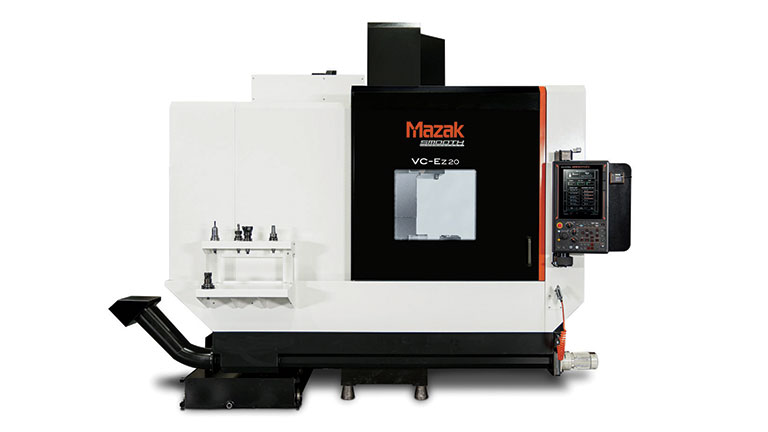
“Someone setting up a three-axis vertical might use a wiggler or edge finder to pick up a workpiece location,” Kerscher said. “On a five-axis machine, they’ll more than likely need a touch probe, and quite possibly one of those spherical ball devices from Renishaw or another provider to determine the axes of rotation. That’s not to say it’s terribly difficult, but it’s definitely a skillset progression that should be accounted for when investing in a new machine or hiring an operator.”
Finding the Center
The good news is that five-axis machining center operation is getting easier all the time. That’s according to Errol Burrell, machine center product specialist for Okuma America Corp., Charlotte, N.C., who can lay claim to 25 years of five-axis experience. Not only are CAM systems becoming more “five-friendly” than they once were, he said, but machine tool builders have introduced automatic calibration systems that eliminate much of the guesswork described earlier.
“When I was first introduced to five-axis machines, you practically needed a degree from MIT to set one up,” he said. “You had to know the location of the rotary pivot points and the constant surface, which is your table, and the spindle gauge line, the tool lengths, and all these values had to be factored in when you generated the program. That’s not the case now with the invention of what Okuma calls tool center point control, or TCPC.”
Burrell explained that each machine builder has its own version of TCPC, but all do the same thing—make it easy to determine the part’s center of rotation. Most also offer features similar to Okuma’s dynamic fixture offset, five-axis autotuning, posture control, and more, all of which take the hassle out of five-axis. “We no longer care about all the stuff we had to deal with because it’s all calculated automatically in the background, either in the machine control or in the CAM system. It’s much simpler than it once was.”
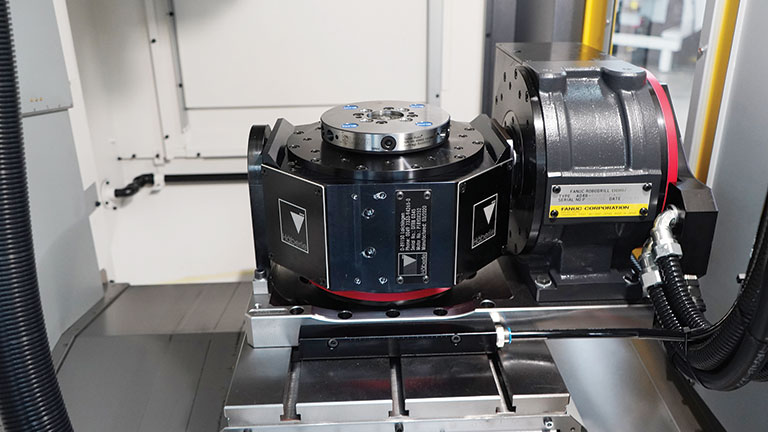
Bolt-on Blues
Investment in a new machine tool isn’t a prerequisite to five-axis machining. Burrell and several others interviewed for this article noted that many shops get their feet wet by first purchasing a rotary table for four-axis work, or a trunnion-style tilt-rotary for 3+2 and five-axis simultaneous machining. And while this is a good solution for some applications, it does present some caveats.
The first is that all of the five-axis niceties just mentioned don’t exist on a three-axis VMC. And while their lack might not require the operator to have the MIT education of Burrell’s early days, not having them will make setup and troubleshooting more challenging, enough so that competing with a true five-axis shop is unlikely.
The second is tool length. Given that a typical trunnion table can measure 14" (35.56 cm) or more in height, the 20" (50.8 cm) or so of Z-axis travel common on many vertical mills is quickly eaten up. Simply put, installing a tilt-rotary table on most VMCs is like putting a fish finder and trolling motor on an old Crestliner—you might catch a few crappies, but it’ll never be the Bass Cat you’ve been hoping for. “Rotary tables and trunnions are limited, but if you don’t have the cash or your needs are minimal, it’s still a good way to ease into four- and five-axis machining.”
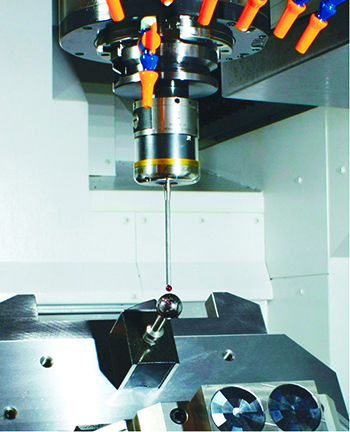
Drilling Right
Thomas Saur, vice president of FANUC America products at Methods Machine Tools Inc., Sudbury, Mass., suggested that the shift from three- to four- or five-axis machining is like a high tide rolling onto shore, adding that many of his customers invest in one of FANUC’s three-axis RoboDrill machining centers one year and add a four- or five-axis table the next. And because the machines are designed for such a transition, the limitations just mentioned don’t apply. Furthermore, these customers often add one of the company’s automation solutions at the same time.
Whatever the make or model of machine tool, however, Saur does agree that five-axis machining requires a greater investment in technology and people alike. “You absolutely need skilled people,” he said. “You need the right programming system, the right workholding and machine accessories, and you should probably have some kind of toolpath simulation software because of five-axis’ greater crash potential. But if you do all these things right, it’s a great way to reduce WIP, improve part quality, and open the door to new opportunities.”
Saur related a story of Command Technology, a shop in Maryland, that made such an investment. By installing a robot capable of changing pallets and toolholders, the shop can now run up to 60 unique part numbers unattended, even those that are new to the company. “These guys are among the best in the industry, but it shows what’s possible,” he said. “They trust the machine, they trust the programming system, and they trust the people. That allows them to load it up with blanks on Friday afternoon and come back to finished parts on Monday. It’s an example that many shops should follow.”
Why Five Axes?
Tony Pekalski, president of Carson, Calif.-based YCM Technology (USA) Inc., said that success with any five-axis VMC depends on several factors, many of them already listed. These include operator skill level, the amount and type of work available for the machine, accuracy requirements, and more. Sitting somewhere near the top of this list, however, is the amount of material that must be removed from the workpiece.
“For heavy stock removal, a three-axis vertical is often a better choice, due to the fact that you generally can’t run the same feedrates and depths of cut on a trunnion,” he said. “On the flip side, you’re always better off from an accuracy perspective if you can machine as much as possible in a single operation, which five-axis machinery is obviously better at. These variables are why it’s important for any shop to partner with someone knowledgeable with all types of machine tools before investing in one.”

Pekalski elaborated on this statement, suggesting that a good supplier should not only understand the different applications for three-, four-, or five-axis machine tools, but also understand the different designs available within each. For example, YCM offers five different styles of five-axis machines. These include C-frame, bridge, ram, and gantry mills, each equipped with a trunnion, as well as double-column and gantry verticals with two-axis heads. A horizontal trunnion-style machining center is on the horizon.
Does it matter? Yes said Pekalski. “Aerospace, automotive, medical, energy, heavy equipment—there are so many different market segments out there, each with a wide variety of parts and materials, that it’s impossible to have one style of machine that does each one well. That’s why we have such a diverse offering, so as to compete in each of these markets.”
Now What?
It’s important to note that other builders boast similar machine tool diversity, and for similar reasons. It’s up to the buyers of such equipment to wade through the endless specifications, time studies, cutting demonstrations, and sage advice from salespeople to decide which machine best fits their needs. One thing that Pekalski and his colleagues all agree on is this: most shops need multiple styles and even brands of machine tools to remain competitive.
“There is no one-size-fits-all solution, no matter who you are,” he said. “For the reasons I offered earlier, some shops will rough on a large, heavy-duty, five-axis machine and finish on a smaller one. A great many of them use five-axis for 3+2 work, which means they can put that same work on a three-axis mill if needed. Others are perfectly content with a whole row of three-axis machines, while the majority of them can probably use both, even though they haven’t yet made that decision. It’s our job as machine builders to educate our customers, provide them with high-quality equipment and automation options, and then support them for as long as they need us.”
"really" - Google News
January 18, 2021 at 08:03PM
https://ift.tt/35OGqzG
VMCs: How Many Axes Do You Really Need? - Advanced Manufacturing
"really" - Google News
https://ift.tt/3b3YJ3H
https://ift.tt/35qAk7d
Bagikan Berita Ini














0 Response to "VMCs: How Many Axes Do You Really Need? - Advanced Manufacturing"
Post a Comment